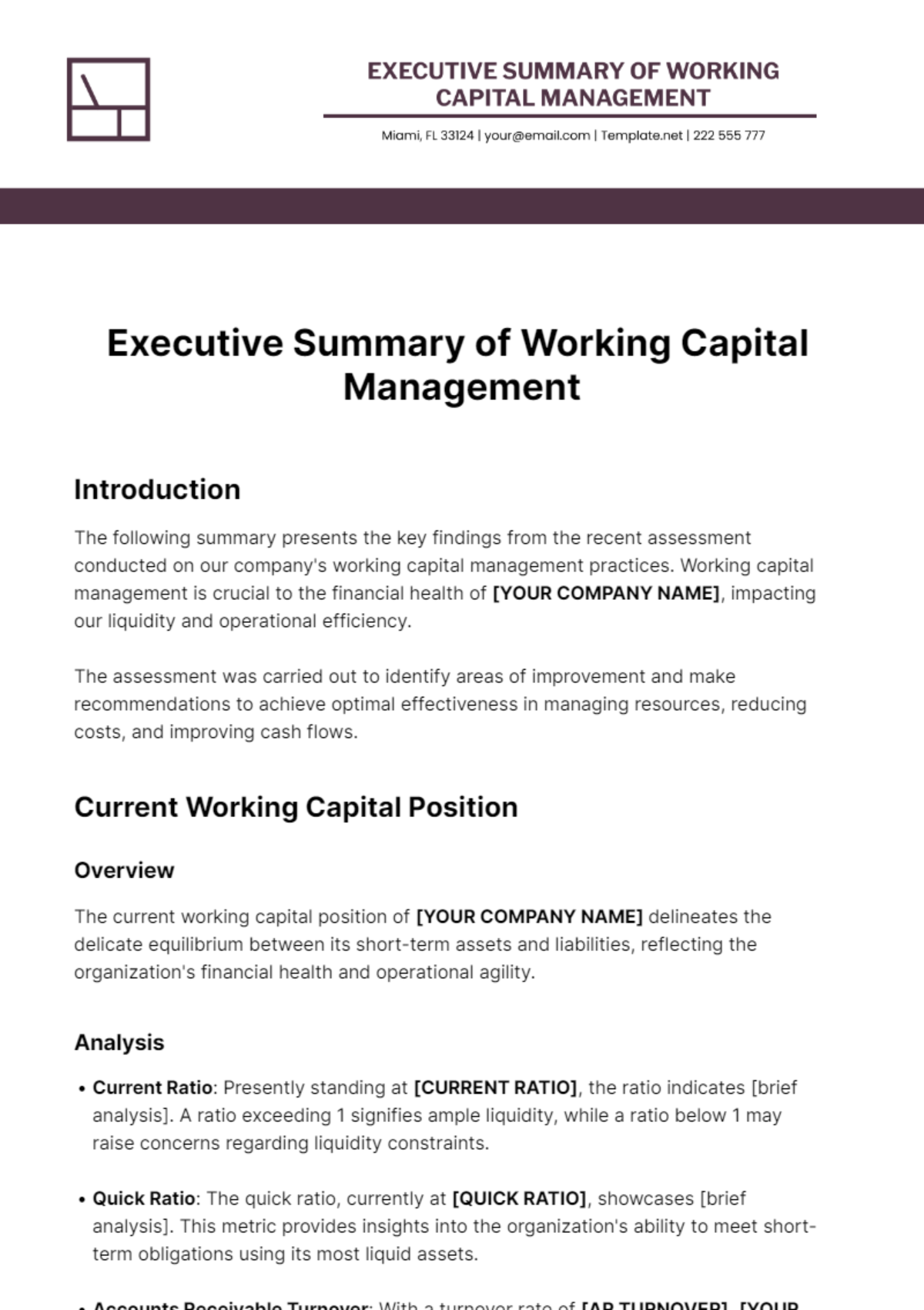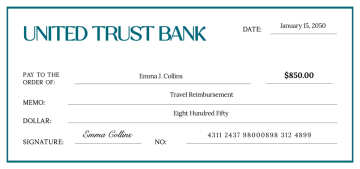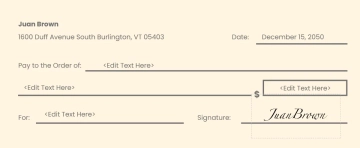Executive Summary of Working Capital Management
Introduction
The following summary presents the key findings from the recent assessment conducted on our company's working capital management practices. Working capital management is crucial to the financial health of [YOUR COMPANY NAME], impacting our liquidity and operational efficiency.
The assessment was carried out to identify areas of improvement and make recommendations to achieve optimal effectiveness in managing resources, reducing costs, and improving cash flows.
Current Working Capital Position
Overview
The current working capital position of [YOUR COMPANY NAME] delineates the delicate equilibrium between its short-term assets and liabilities, reflecting the organization's financial health and operational agility.
Analysis
Current Ratio: Presently standing at [CURRENT RATIO], the ratio indicates [brief analysis]. A ratio exceeding 1 signifies ample liquidity, while a ratio below 1 may raise concerns regarding liquidity constraints.
Quick Ratio: The quick ratio, currently at [QUICK RATIO], showcases [brief analysis]. This metric provides insights into the organization's ability to meet short-term obligations using its most liquid assets.
Accounts Receivable Turnover: With a turnover rate of [AR TURNOVER], [YOUR COMPANY NAME] demonstrates [brief analysis]. A higher turnover rate signifies efficient management of accounts receivable, translating to quicker cash conversion.
Inventory Turnover: At [ INVENTORY TURNOVER], [YOUR COMPANY NAME] exemplifies [brief analysis]. This metric gauges the efficiency of inventory management and the organization's ability to minimize carrying costs.
Recommendations
To optimize working capital efficiency and bolster financial resilience, [YOUR COMPANY NAME] should prioritize the following initiatives:
Improving Accounts Receivable Management: Implement proactive collection strategies to reduce Days Sales Outstanding (DSO) and enhance cash flow.
Enhancing Inventory Management: Deploy advanced inventory forecasting techniques and just-in-time inventory systems to minimize excess inventory and associated costs.
Negotiating Supplier Payment Terms: Negotiate favorable payment terms with suppliers to optimize cash flow and mitigate liquidity constraints.
Key Outcomes
The successful implementation of the proposed strategies will yield several key outcomes crucial for [YOUR COMPANY NAME] financial health and operational effectiveness
Enhanced Liquidity: By adopting proactive measures to manage working capital, [YOUR COMPANY NAME] will fortify its liquidity position, ensuring sufficient funds are available to meet short-term obligations and capitalize on emerging opportunities. This will [IMPACT ON BUSINESS OPERATIONS]
Improved Cash Flow: Through diligent cash flow management practices, [YOUR COMPANY NAME] will optimize the utilization of available funds while mitigating the risk of liquidity constraints. This will facilitate smoother day-to-day operations and empower the organization to [IMPACT ON FINANCIAL STABILITY].
Risk Mitigation: The implementation of robust credit assessment protocols and proactive collection strategies will enable [YOUR COMPANY NAME] to mitigate credit risk exposure and minimize the incidence of bad debt losses. This proactive approach to risk management will safeguard the organization's financial stability and reputation, fostering trust and confidence among stakeholders.
Summary
This Executive Summary equips [YOUR COMPANY NAME] with a comprehensive framework for optimizing working capital management, thereby ensuring financial stability, resilience, and sustainable growth in the dynamic business landscape. By implementing the recommended strategies, [YOUR COMPANY NAME] can enhance liquidity, mitigate financial risks, and drive long-term profitability.
Assessment Results
Overall, the assessment discovered a significant level of inefficiency in the current working capital management process. Despite being well-funded, [YOUR COMPANY NAME] could save up to 15% of operating costs by improving its working capital management.
The inefficiencies can be attributed to inconsistencies in tracking vendor payments, ineffective inventory management, receivables collection, and inadequate cash flow forecasts.
Areas | Current State | Recommendations |
|---|
Vendor Payment Tracking | Inconsistencies in payment tracking lead to late payment penalties and strained relationships with suppliers. | Implement a system to manage and track payments to prevent missed or late payments. |
Inventory Management | The current system is not capable of providing an accurate, real-time overview of inventory. | Adopt an advanced inventory management system to optimize stock levels and reduce holding costs. |
Receivables Collection | There is a lack of stringent follow-up protocols for late payments from clients. | Introduce stricter receivables collection measures and incentives for early payments. |
Cash Flow Forecasts | The current cash forecasting practices are inadequate and do not effectively predict future cash flows. | Adopt more sophisticated forecasting models to enhance the accuracy of cash flow projections. |
Conclusion
Reforming our working capital management will contribute significantly to [Your Company Name]'s profitability and sustainability. The benefits of these improvements will be realized not just in monetary terms but also in better relationships with vendors and clients and increased operational efficiency.
By taking the above actions, [YOUR COMPANY NAME] will be better positioned to capitalize on growth opportunities, mitigate risks and maximize shareholder wealth.
Summary Templates @ Template.net






























